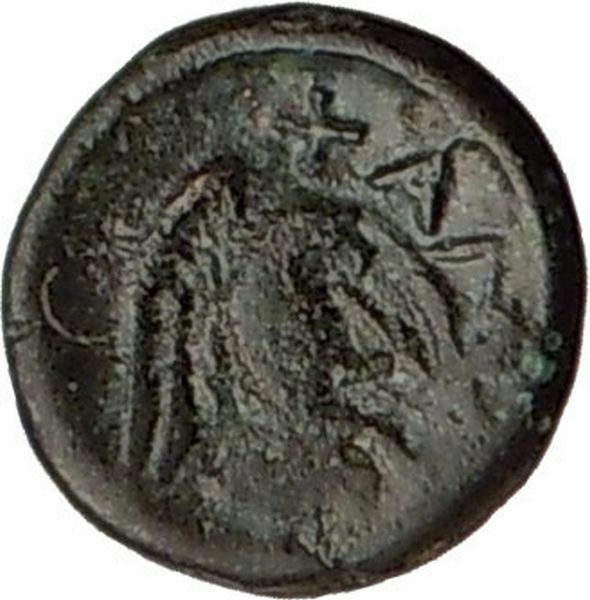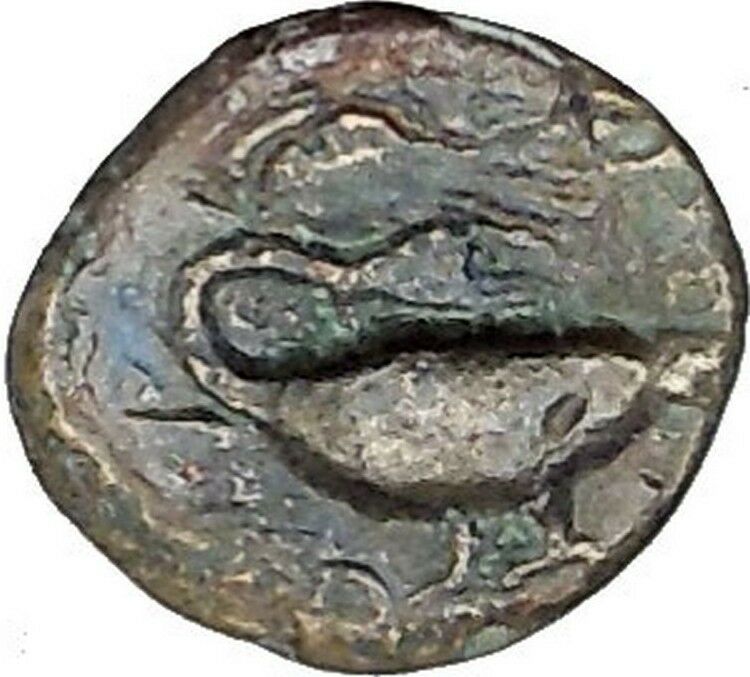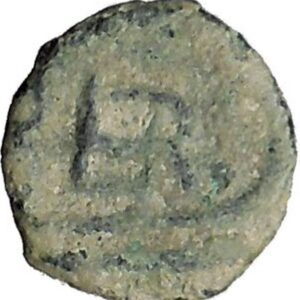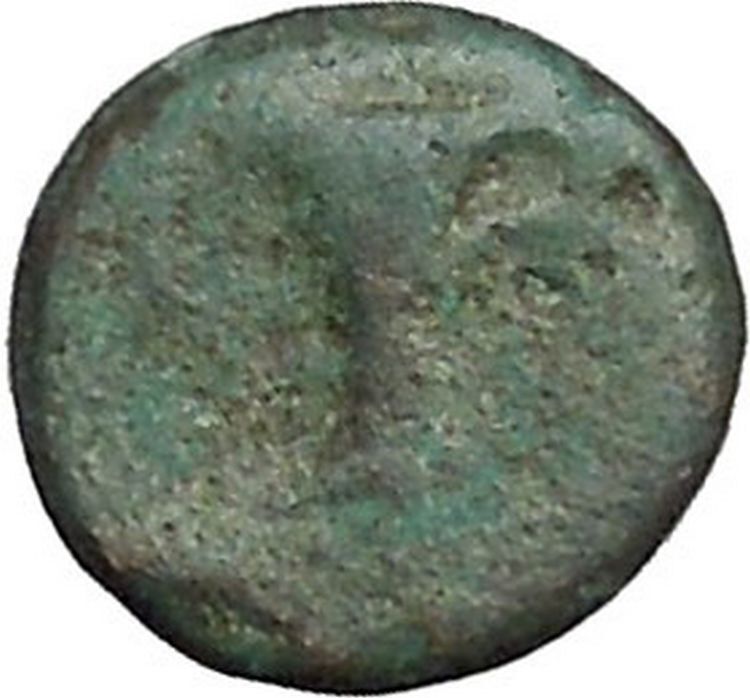|
Greek – IONIA. Klazomenai
Bronze 12mm (1.33 grams) Struck 350-300 B.C.
Reference: Sear 4324
Head of Athena three-quarter face to right, wearing triple-crested helmet.
Ram walking right; ΒΙΩΝ above, pellet before. –
Situated on the southern shores of the Gulf of Smyrna,
Klazomenai was the birthplace
of the philosopher Anaxagoras.
You are bidding on the exact item pictured,
provided with a Certificate of Authenticity and Lifetime Guarantee of
Authenticity.
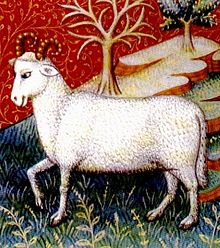
Aries
(♈) is the first
astrological sign
in the
Zodiac
, spanning the first 30 degrees of
celestial longitude
(0°≤
λ <30º). Under the tropical zodiac, the Sun transits this
constellation between March 21 to April
20 each year. Under the sidereal zodiac, the sun currently transits Aries
from 15 April to 15 May (approximately).
According to the
Tropical
system of astrology, the
Sun
enters the sign of Aries when it reaches
the
northern vernal equinox
, which occurs around
March 21. Due to the fact that the Earth takes approximately 365.25 days to go
around the Sun, the precise time of the equinox is not the same each year, and
generally will occur about 6 hours later each year, with a jump of a day
(backwards) on leap years. Since 1900 the vernal equinox date ranged from March
20 at 08h (2000) to March 21 at 19h (1903) (all times UTC).
Individuals born during these dates, depending on which system of astrology
they subscribe to, may be called Arians or Ariens.
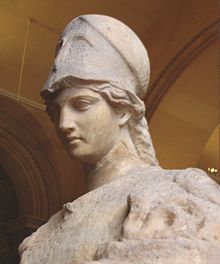
Helmeted Athena with the cista and Erichthonius in his serpent form.
Roman, first century (Louvre
Museum)
In
Greek religion
and
mythology
, Athena or Athene, also
referred to as Pallas Athena/Athene , is the goddess of wisdom, courage,
inspiration, civilization, law and justice, just warfare, mathematics, strength,
strategy, the arts, crafts, and skill.
Minerva
is the
Roman goddess
identified with
Athena.
Athena is also a shrewd companion of
heroes and is the
goddess
of heroic endeavour. She is the
virgin
patroness of
Athens
. The Athenians founded the
Parthenon
on the Acropolis of her namesake
city, Athens (Athena Parthenos), in her honour.
Athena’s veneration as the patron of Athens seems to have existed from the
earliest times, and was so persistent that archaic myths about her were recast
to adapt to cultural changes. In her role as a protector of the city (polis),
many people throughout the Greek world worshiped Athena as Athena Polias
(Ἀθηνᾶ Πολιάς “Athena of the city”). The city of
Athens
and the goddess Athena essentially bear
the same name, “Athenai” meaning “[many] Athenas”.
Patroness
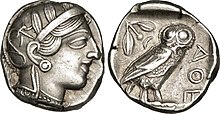
Athenian
tetradrachm
representing the
goddess Athena
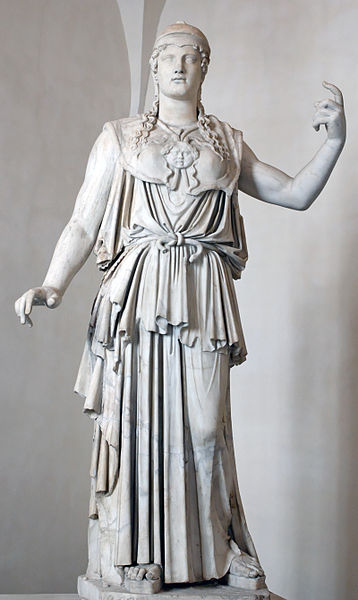
Athena
as the goddess of philosophy became an aspect of the cult in Classical Greece
during the late 5th century B.C. She is the patroness of various crafts,
especially of weaving
, as Athena Ergane, and was
honored as such at festivals such as
Chalceia
. The metalwork of weapons also fell
under her patronage. She led battles (Athena
Promachos or the warrior maiden Athena Parthenos) as the
disciplined, strategic side of war, in contrast to her brother
Ares, the patron of violence, bloodlust and slaughter—”the raw force
of war”. Athena’s wisdom includes the cunning intelligence (metis) of
such figures as Odysseus
. Not only was this version of Athena
the opposite of Ares in combat, it was also the polar opposite of the serene
earth goddess version of the deity, Athena Polias.
Athena appears in Greek mythology as the patron and helper of many heroes,
including Odysseus
,
Jason
, and
Heracles
. In
Classical Greek
myths, she never consorts with
a lover, nor does she ever marry,earning the title Athena Parthenos. A
remnant of archaic myth depicts her as the adoptive mother of
Erechtheus
/Erichthonius
through the foiled rape by
Hephaestus
. Other variants relate that
Erichthonius, the serpent that accompanied Athena, was born to
Gaia
: when the rape failed, the semen landed on
Gaia and impregnated her. After Erechthonius was born, Gaia gave him to Athena.
Though Athena is a goddess of war strategy, she disliked fighting without
purpose and preferred to use wisdom to settle predicaments.The goddess only
encouraged fighting for a reasonable cause or to resolve conflict. As patron of
Athens she fought in the Trojan war on the side of the Achaeans.
Mythology
Lady of Athens
Athena competed with
Poseidon
to be the patron deity of Athens,
which was yet unnamed, in a version of one
founding myth
. They agreed that each would give
the Athenians one gift and that the Athenians would choose the gift they
preferred. Poseidon struck the ground with his
trident
and a salt water spring sprang up; this
gave them a means of trade and water—Athens at its height was a significant sea
power, defeating the
Persian
fleet at the
Battle of Salamis
—but the water was salty and
not very good for drinking.
Athena, however, offered them the first domesticated
olive tree
. The Athenians (or their king,
Cecrops
) accepted the olive tree and with it
the patronage of Athena, for the olive tree brought wood, oil, and food.
Robert Graves
was of the opinion that
“Poseidon’s attempts to take possession of certain cities are political myths”
which reflect the conflict between matriarchal and patriarchal religions.
Other sites of cult
Athena also was the patron goddess of several other Greek cities, notably
Sparta, where the archaic cult of
Athena Alea
had its sanctuaries in the
surrounding villages of
Mantineia
and, notably,
Tegea
. In Sparta itself, the temple of Athena
Khalkíoikos (Athena “of the Brazen House”, often
latinized
as Chalcioecus) was the
grandest and located on the Spartan acropolis; presumably it had a roof of
bronze. The forecourt of the Brazen House was the place where the most solemn
religious functions in Sparta took place.
Tegea was an important religious center of ancient Greece, containing the
Temple of Athena Alea
. The temenos was founded by
Aleus
,
Pausanias
was informed. Votive bronzes at the
site from the Geometric and Archaic periods take the forms of horses and deer;
there are
sealstone
and
fibulae
. In the Archaic period the nine
villages that underlie Tegea banded together in a
synoecism
to form one city. Tegea was listed in
Homer
‘s
Catalogue of Ships
as one of the cities that
contributed ships and men for the
Achaean assault on Troy
.
Judgment of Paris

Aphrodite is being surveyed by Paris, while Athena (the leftmost
figure) and Hera stand nearby.
El Juicio de Paris
by
Enrique Simonet
, ca. 1904
All the gods and goddesses as well as various mortals were invited to the
marriage of Peleus
and
Thetis
(the eventual parents of
Achilles
). Only
Eris
, goddess of discord, was not invited. She
was annoyed at this, so she arrived with a golden apple inscribed with the word
καλλίστῃ (kallistēi, “for the fairest”), which she threw among the goddesses.
Aphrodite, Hera, and Athena all claimed to be the fairest, and thus the rightful
owner of the apple.
The goddesses chose to place the matter before Zeus, who, not wanting to
favor one of the goddesses, put the choice into the hands of Paris, a
Trojan prince. After bathing in the spring of
Mount Ida
(where Troy was situated), the
goddesses appeared before Paris. The goddesses undressed and presented
themselves to Paris naked, either at his request or for the sake of winning.

Paris is awarding the apple to Aphrodite, while Athena makes a face.
Urteil des Paris by
Anton Raphael Mengs
, ca. 1757
Still, Paris could not decide, as all three were ideally beautiful, so they
resorted to bribes. Hera tried to bribe Paris with control over all
Asia and Europe
, while Athena offered wisdom, fame and
glory in battle, but Aphrodite came forth and whispered to Paris that if he were
to choose her as the fairest he would have the most beautiful mortal woman in
the world as a wife, and he accordingly chose her. This woman was
Helen
, who was, unfortunately for Paris,
already married to King
Menelaus
of
Sparta
. The other two goddesses were enraged by
this and through Helen’s abduction by Paris they brought about the
Trojan War
.

The Parthenon
, Temple of Athena
Parthenos
Masculinity and
feminism
Athena had an “androgynous compromise” that allowed her traits and what she
stood for to be attributed to male and female rulers alike over the course of
history (such as Marie de’ Medici, Anne of Austria, Christina of Sweden, and
Catherine the Great)
J.J. Bachofen advocated that Athena was originally a maternal figure stable
in her security and poise but was caught up and perverted by a patriarchal
society; this was especially the case in Athens. The goddess adapted but could
very easily be seen as a god. He viewed it as “motherless paternity in the place
of fatherless maternity” where once altered, Athena’s character was to be
crystallized as that of a patriarch.
Whereas Bachofen saw the switch to paternity on Athena’s behalf as an
increase of power, Freud on the contrary perceived Athena as an “original mother
goddess divested of her power”. In this interpretation, Athena was demoted to be
only Zeus’s daughter, never allowed the expression of motherhood. Still more
different from Bachofen’s perspective is the lack of role permanency in Freud’s
view: Freud held that time and differing cultures would mold Athena to stand for
what was necessary to them.
Klazomenai (also spelled Clazomenae,
Greek
:
Κλαζομεναί
, modern-day Kilizman in
Urla
near
İzmir
in
Turkey
) was an ancient Greek city of
Ionia
and a member of the
Ionian Dodecapolis
(Confederation of Twelve
Cities), it was one of the first cities to issue silver coinage.
Location

Map of Aegean side of Anatolia showing the location of Klazomenai
Klazomenai is located in modern Urla (Vourla in Greek) on the western
coast of Anatolia
, on the southern coast of the
Gulf of İzmir
, at about 20 miles west of İzmir.
The city was originally located on the mainland, but probably during the early
fifth-century
Ionian Revolt
from the
Persians
, it was moved to an island just off
the coast, which
Alexander the Great
eventually connected to the
mainland with a causeway. The location of the city-around a harbour, backed by a
coastal plain and low hills to the south provided a number of locations for
settlement, and as such, settlements did shift from location to location over
time. This can be shown by the island of Karantina, located to the north of the
settlement area-which became settled at certain points in the history of
Klazomenai.
Mythology
The principal god of the city was
Apollo
. According to myth, swans drew the
chariot in which Apollo every year flew south from his winter home in the land
of the
Hyperboreans
. But Klazomenai was also home to
large numbers of swans, and it is thought that the verb klazo was used to
describe the call of the wild birds. The swan on the obverse is both an
attribute of Apollo
and a pun on the name Klazomenai.
Ancient
times
Though not in existence before the arrival of the
Ionians
in Asia, its original founders were
largely settlers from
Phlius
and
Cleonae
. It stood originally on the
isthmus
connecting the mainland with the
peninsula on which
Erythrae
stood; but the inhabitants, alarmed by
the encroachments of the
Persians
, removed to one of the small islands
of the bay, and there established their city. This island was connected with the
mainland by
Alexander the Great
by means of a pier, the
remains of which are still visible.
During the 5th century it was for some time subject to the
Athenians
, but about the middle of the
Peloponnesian War
(412 BC) it revolted. After a
brief resistance, however, it again acknowledged the Athenian supremacy, and
repelled a
Lacedaemonian
attack. In 387 BC Klazomenai and
other cities in Asia were taken over by
Persia
, but the city continued to issue its own
coins.
Under the Romans Clazomenae was included in the province of Asia, and enjoyed
an immunity from
taxation
.
Klazomenai is today perhaps best-known as the birthplace of the philosopher
Anaxagoras
, often styled “Anaxagoras of
Clazomenae”.
Archaeology
The site of Liman Tepe, which lies near an old harbour contans very important
Bronze Age excavations, the most prominent and remarkable of which is the amount
of varying archaic burial sites, as well as evidence of the practises associated
with them close by. One possible explanation for this is that these sites were
used by different social groups within society.
The city was famous for production and exports of olive oil and its painted
terracotta
sarcophagi
, which are the finest monuments of
Ionian painting in the 6th century BC.
It was also prized for its variety of
garum
.
Ancient
olive press
Olive oil extraction
installation (işlik)
dating back to the third quarter of the 6th century BC uncovered in Klazomenai
is the only surviving example of a level and weights press from an ancient Greek
city and precedes by at least two centuries the next securely datable earliest
presses found in Greece.
[1]
. It was restored and reconstructed in
2004-2005 through collaboration between
Ege University
, a Turkish olive-oil exporter
and a German
natural building components company, as
well as by local artisans, on the basis of the clearly visible
millstone
with a cylindrical roller and three
separation pits. The olive oil obtained turned out to be quite a success in
business terms as well.
|
|
restoration and reconstruction
|
|
general view after completion of works
|
Financial
pioneers
In an event noted by
Aristotle
, Klazomenians also appear as
financial pioneers in
economic history
, for having used one
commodity
(olive oil), in an organized
manner and on a city-scale, to purchase another (wheat), with
interests
refundable on the value of the first.
Around 350 B.C., suffering from a shortage of grain and scarcity of funds, the
rulers of the city passed a resolution calling on citizens who had stores of
olive oil to lend to the city at interest. The loan arranged, they hired vessels
and sent them to ports of exportation of grain and bought a
consignment
on the pledged security of the
value of the oil
[2]
.
Payment & Shipping:
Will accept payments via PayPal.
About Seller:
Dr. Sergey Nechayev is a Professor at Long Island University
& international ancient coin expert and dealer. Participated in many
international coin shows, including NYINC (New York International Numismatic
Convention). All coins are provided with a certificate of authenticity based on
many years of professional experience. All items are guaranteed genuine for a
lifetime. Bid with confidence today!
Ionia is an ancient region of central coastal
Anatolia
in present-day
Turkey
, the region nearest
İzmir
, which was historically
Smyrna
. It consisted of the northernmost
territories of the
Ionian League
of
Greek
settlements. Never a unified state, it
was named after the
Ionian tribe
who, in the
Archaic Period
(800–480 BC), settled mainly the
shores and islands of the
Aegean Sea
. Ionian states were identified by
tradition and by their use of
Eastern Greek
.
Ionia proper comprised a narrow coastal strip from
Phocaea
in the north near the mouth of the
river Hermus
(now the
Gediz
), to
Miletus
in the south near the mouth of the
river
Maeander
, and included the islands of
Chios
and
Samos
. It was bounded by
Aeolia
to the north,
Lydia
to the east and
Caria
to the south. The cities within the
region figured large in the strife between the
Persian Empire
and the Greeks.
According to
Greek
tradition, the cities of Ionia were
founded by
colonists
from the other side of the Aegean.
Their settlement was connected with the legendary history of the Ionic people in
Attica
, which asserts that the colonists were
led by Neleus and Androclus, sons of
Codrus
, the last
king of Athens
. In accordance with this view
the “Ionic migration”, as it was called by later chronologers, was dated by them
one hundred and forty years after the
Trojan war
, or sixty years after the return of
the Heracleidae
into the
Peloponnese
.
Geography
Physical
Ionia was of small extent, not exceeding 150 kilometres (90 mi) in length
from north to south, with a breadth varying from 60 to 90 kilometres (40 to 60
mi), but to this must be added the peninsula of
Mimas
, together with the two islands. So
intricate is the coastline that the voyage along its shores was estimated at
nearly four times the direct distance. A great part of this area was, moreover,
occupied by mountains. Of these the most lofty and striking were Mimas and
Corycus, in the peninsula which stands out to the west, facing the island of
Chios;
Sipylus
, to the north of Smyrna, Corax,
extending to the south-west from the Gulf of Smyrna, and descending to the sea
between Lebedus and Teos; and the strongly marked range of
Mycale
, a continuation of Messogisin the
interior, which forms the bold headland of Trogilium or Mycale, opposite Samos.
None of these mountains attains a height of more than 1,200 metres (3,940 ft).
The district comprised three extremely fertile valleys formed by the outflow of
three rivers, among the most considerable in Asia Minor: the
Hermus
in the north, flowing into the
Gulf of Smyrna
, though at some distance from
the city of that name; the Caster, which flowed under the walls of Ephesus; and
the
Maeander
, which in ancient times discharged its
waters into the deep gulf that once bathed the walls of Miletus, but which has
been gradually filled up by this river’s deposits. With the advantage of a
peculiarly fine climate, for which this part of
Asia Minor
has been famous in all ages, Ionia
enjoyed the reputation in ancient times of being the most fertile of all the
rich provinces of Asia Minor; and even in modern times, though very imperfectly
cultivated, it produces abundance of fruit of all kinds, and the
raisins
and
figs
of Smyrna supply almost all the markets of
Europe. (Needs citation. The above description reads to be a verbatum quote from
an Englishman’s travelogue.)
Political
The geography of Ionia placed it in a strategic position that was both
advantageous and disadvantageous. Ionia was always a maritime power founded by a
people who made their living by trade in peaceful times and marauding in
unsettled times. The coast was rocky and the arable land slight. The native
Luwians for the most part kept their fields further inland and used the rift
valleys for wooded pasture. The coastal cities were placed in defensible
positions on islands or headlands situated so as to control inland routes up the
rift valleys. The people of those valleys were of different ethnicity. The
populations of the cities were multi-cultural and received cultural stimuli from
many civilizations in the eastern
Mediterranean
, which resulted in a brilliant
society able to make contributions of worldwide and millennial significance.
On the other hand Ionia was divided by the Aegean Sea from the mother country
and could seldom be defended from there. Many imperial powers arose inland
against which Ionia was forced to defend itself and to whom it was typically
required finally to submit.
Demography
Ancient demographics are available only from literary sources.
Herodotus
states that in Asia the Ionians kept
the division into twelve cities that had prevailed in Ionian lands of the north
Peloponnese, their former homeland, which became
Achaea
after they left.These Asian cities were
(from south to north)
Miletus
,
Myus, Priene
,
Ephesus
,
Colophon
,
Lebedos
,
Teos,
Erythrae
,
Clazomenae
and
Phocaea
, together with
Samos
and
Chios
.
Smyrna
, originally an
Aeolic
colony, was afterwards occupied by
Ionians from Colophon, and became an Ionian city — an event which had taken
place before the time of Herodotus.These cities do not match those of
Achaea
. Moreover, the Achaea of Herodotus’ time
spoke Doric
(Corinthian), but in
Homer
it is portrayed as being in the kingdom
of Mycenae
, which most likely spoke
Mycenaean Greek
, which is not Doric. If the
Ionians came from Achaea, they departed during or after the change from East
Greek to West Greek there. Mycenaean continued to evolve in a pocket,
Arcadia
.
There is no record of any people named Ionians in
Late Bronze Age
Anatolia but
Hittite texts
record the Achaeans of
Ahhiyawa
, of location not completely certain,
but in touch with the Hittites of that time.
Miletus
and some other cities founded earlier
by non-Greeks received populations of
Mycenaean Greeks
probably under the name of
Achaeans. The tradition of Ionian colonizers from Achaea suggests that they may
have been known by both names even then. In the absence of archaeological
evidence of discontinuity at Miletus the Achaean population whatever their name
appears to have descended to archaic Ionia, which does not exclude the
possibility of another colonizing and founding event from Athens.
Herodotus expresses some impatience at the ethnic views of his countrymen
concerning Ionia: “for it would be foolishness to say that these are more truly
Ionian or better born ….”[5]
He lists other ethnic populations among the settlers: Abantes from
Euboea
,
Minyans
from
Orchomenus
, Cadmeians,
Dryopians
,
Phocians
,
Molossians
, Arcadian
Pelasgians
,
Dorians
of
Epidaurus
, and others. The presence of Doric
Ionians is somewhat contradictory, but Herodotus himself, a major author of the
Ionic dialect, was from a Doric city,
Halicarnassus
. Even ” the best born of the
Ionians”, the Athenians, married girls from
Caria
. “Yet since they set more store by the
name than the rest of the Ionians, let it be granted that those of pure birth
are Ionians.”[6]
History

Greek city-unions in Anatolia, Blue are Ion cities
From the 18th century BC the region was a part of the
Hittite Empire
with possible name
Arzawa
,which was destroyed by invaders during
the 12th century BC together with the collapse of the Empire. Ionia was settled
by the Greeks probably during the 11th century BC. The most important city was
Miletus
(the Milawanta of Hittites).
Several centuries later Ionia was the place where western philosophy began and
was the homeland of
Heraclitus
,
Thales
,
Anaximander
and
Anaximenes
. They were natural-philosophers of
the Ionian school of philosophy and tried to explain the phenomena according to
no-supernatural laws. They also searched a simple material-form behind the
appearances of things (origin) and this conception had a great influence on the
early archaic art in Greece.
Settlement
During the late 13th century BC the peoples of the
Aegean Sea
took to marauding and resettling as
a way of life and were called by the Egyptians the
Sea Peoples
.[citation
needed] Mycenaean Greeks must have been among them.
They settled lightly on the shores of
Luwian
Anatolia often by invitation. In the
background was the stabilizing influence of the Hittites, who monitored maritime
movement and suppressed piracy. When that power was gone the Luwian people
remained in the vacuum as a number of coastal splinter states that were scarcely
able now to defend themselves. Ionian Greeks took advantage of opportunities for
coastal raiding: an inscription of
Sargon II
(ca 709-07,recording a naval
expedition of 715) boasts “in the midst of the sea” he had “caught the Ionians
like fish and brought peace to the land of Que
Cilicia
and the city of
Tyre
“. For a full generation earlier Assyrian
inscriptions had recorded troubles with the Ionians, who escaped on their boats.[7]
Caria
and
Lycia
came to the attention of
Athens
, most powerful state remaining in
Greece, which also had lost its central government ruling from
Mycenae
, now burned and nearly vacant. Ionians
had been expelled from the
Peloponnesus
by the
Dorians
and had sought refuge in Athens. The
Athenian kings decided to relieve the crowding by resettling the coast of Lydia
with Ionians from the Peloponnesus under native Athenian leadership.
They were not the only Greeks to have such a perception and reach such a
decision. The Aeolians
of
Boeotia
contemporaneously settled the coast to
the north of the Ionians and the newly arrived
Dorians
of
Crete
and the islands the coast of
Caria
. The Greeks descended on the
Luwians
of the Anatolian coast in the 10th
century BC. The descent was not peaceful and the Luwians were not willing.
Pausanias
gives a thumbnail sketch of the
resettlement.[8]
Miletus
was the first city attacked, where
there had been some Mycenaean Greeks apparently under the rule of
Cretans
. After overthrowing the Cretan
government and settling there the Ionians widened their attack to
Ephesus
,
Samos
and
Priene
. Combining with
Aeolians
from
Thebes
they founded
Myus.
Colophon
was already in the hands of Aeolians
who had arrived via Crete in Mycenaean times. The Ionians “swore a treaty of
union” with them. They took
Lebedos
driving out the Carians and augmented
the Aeolian population of
Teos. They settled on
Chios
, took
Erythrae
from the Carians, Pamphylians (both
Luwian) and Cretans.
Clazomenae
and
Phocaea
were settled from
Colophon
. Somewhat later they took
Smyrna
from the Aeolians.
Brief autonomy
The Ionian cities formed a religious and cultural (as opposed to a political
or military) confederacy, the
Ionian League
, of which participation in the
Panionic festival
was a distinguishing
characteristic. This festival took place on the north slope of
Mt. Mycale
in a shrine called the
Panionium
. In addition to the Panionic festival
at Mycale, which was celebrated mainly by the Asian Ionians, both European and
Asian coast Ionians convened on
Delos
Island each summer to worship at the
temple of the Delian
Apollo
.
But like the
Amphictyonic league
in Greece, the Ionic was
rather of a sacred than a political character; every city enjoyed absolute
autonomy, and, though common interests often united them for a common political
object, they never formed a real confederacy like that of the Achaeans or
Boeotians
. The advice of
Thales
of Miletus to combine in a political
union was rejected.
The colonies naturally became prosperous.
Miletus
especially was at an early period one
of the most important commercial cities of Greece; and in its turn became the
parent of numerous other colonies, which extended all around the shores of the
Euxine Sea
and the Propontis from Abydus and
Cyzicus
to
Trapezus
and Panticapaeum.
Phocaea
was one of the first Greek cities whose
mariners explored the shores of the western Mediterranean.
Ephesus
, though it did not send out any
colonies of importance, from an early period became a flourishing city and
attained to a position corresponding in some measure to that of Smyrna at the
present day.
Under the
last Anatolian empire
About 700 BC
Gyges
, first Mermnad king of
Lydia
, invaded the territories of Smyrna and
Miletus, and is said to have taken
Colophon
as his son Ardys did Priene. The first
event in the history of Ionia for which there is a trustworthy account is the
inroad of the
Cimmerii
, who ravaged a great part of Asia
Minor, including Lydia, and sacked
Magnesia on the Maeander
, but were foiled in
their attack upon Ephesus. This event may be referred to the middle of the 7th
century BC. It was not until the reign of
Croesus
(560–545 BC) that the cities of Ionia
fell completely under Lydian rule.
Satrapy of the
Achaemenids
The defeat of Croesus by
Cyrus
was followed by the conquest of all the
Ionian cities. These became subject to the Persian monarchy with the other Greek
cities of Asia. In this position they enjoyed a considerable amount of autonomy,
but were for the most part subject to local despots, most of whom were creatures
of the Persian king. It was at the instigation of one of these despots,
Histiaeus of Miletus
, that in about 500 BC the
principal cities ignited the
Ionian Revolt
against Persia. They were at
first assisted by the Athenians and
Eretria
, with whose aid they penetrated into
the interior and burnt Sardis, an event which ultimately led to the
Persian invasion of Greece
. But the fleet of
the Ionians was defeated off the island of
Lade
, and the destruction of Miletus after a
protracted siege was followed by the reconquest of all the Asiatic Greeks,
insular as well as continental.
Autonomy
under the Athenian empire
The victories of the Greeks during the great Persian war had the effect of
enfranchising their kinsmen on the other side of the Aegean; and the
battle of Mycale
(479 BC), in which the defeat
of the Persians was in great measure owing to the Ionians, secured their
emancipation. They henceforth became the dependent allies of Athens (see
Delian League
), though still retaining their
autonomy, which they preserved until the
peace of Antalcidas
in 387 BC once more placed
them as well as the other Greek cities in Asia under the nominal dominion of
Persia.
Satrapy again
Ionian cities appear to have retained a considerable amount of freedom until
the invasion of Asia Minor by
Alexander the Great
.
Hellenistic period
After the
battle of the Granicus
most of the Ionian
cities submitted to the rule of
Alexander III
of
Macedon
and his
Diadochi
. As such Ionia enjoyed a great
prosperity during the
Hellenistic
times with the notable exception of
Miletus
, which, being the only city of the
Ionian League
to deny to pay homage to
Alexander
, was finally leveled after a long
siege at 334
BC
, and never restored to its previous
splendor.
Under Rome
Ionia became part of the Roman province of Asia.
Legacy
Ionia has laid the world under its debt not only by giving birth to a long
roll of distinguished men of letters and science (notably the
Ionian School
of philosophy), but also by
originating the distinct school of art which prepared the way for the brilliant
artistic development of Athens in the 5th century BC. This school flourished
between 700 and 500 BC, and is distinguished by the fineness of workmanship and
minuteness of detail with which it treated subjects, inspired always to some
extent by non-Greek models. Naturalism is progressively obvious in its
treatment, e.g. of the human figure, but to the end it is still subservient to
convention. It has been thought that the Ionian
migration
from Greece carried with it some part
of a population which retained the artistic traditions of the
Mycenaean civilization
, and so caused the birth
of the Ionic school; but whether this was so or not, it is certain that from the
8th century BC onwards we find the true spirit of Hellenic art, stimulated by
commercial intercourse with eastern civilizations, working out its development
chiefly in Ionia and its neighbouring isles. The great names of this school are
Theodorus
and Rhoecus of Samos;
Bathycles
of
Magnesia on the Maeander
;
Glaucus of Chios
, Melas, Micciades, Archermus,
Bupalus and Athenis
of
Chios
. Notable works of the school still extant
are the famous archaic female statues found on the Athenian Acropolis in
1885–1887, the seated statues of Branchidae, the Nike of Archermus found at
Delos, and the objects in
ivory
and
electrum
found by D.G. Hogarth in the lower
strata of the Artemision at Ephesus.
The
Arabic
,
Turkish
,
Persian
and
Urdu
name for
Greek
is Younan (یونان), a
transliteration of “Ionia.” The same is true for the
Hebrew
word, “Yavan” (יוון) and the
Sanskrit
word “yavana“.
Not to be confused with the meaning of the Assyrian name Younan (also spelled,
Yonan), a transliteration of Jonah, from the Aramaic and Hebrew, “Yonah”,
meaning dove or peace.
This entry was originally from the
1911 Encyclopædia Britannica
.
|



















